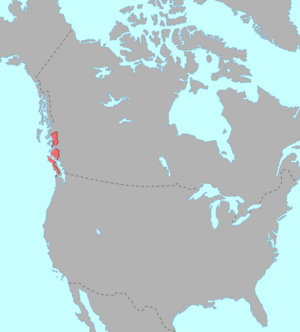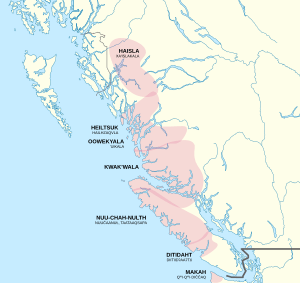Wakashan languages facts for kids
Quick facts for kids Wakashan |
|
|---|---|
| Geographic distribution: |
British Columbia, Canada |
| Linguistic classification: | One of the world's primary language families |
| Subdivisions: |
Northern
Southern
|
| ISO 639-2 and 639-5: | wak |
 Pre-contact distribution of Wakashan languages
|
|
The Wakashan languages are a group of languages spoken by Indigenous peoples in British Columbia, Canada. You can find these languages spoken around and on Vancouver Island. They are also spoken in the northwestern part of the Olympic Peninsula in Washington state, USA. This area is on the south side of the Strait of Juan de Fuca.
Like many languages from the Northwest Coast, Wakashan languages have many different consonant sounds. These sounds often come together in long, complex groups called consonant clusters.
Contents
Wakashan Language Groups
The Wakashan language family is divided into two main groups. These groups include seven different languages.
Northern Wakashan Languages
This group is also known as Kwakiutlan languages.
- Haisla (also called Xaʼislak'ala or Haisla-Henaksiala)
- About 200 people spoke Haisla in 2005.
- It has two main dialects: X̄a'islak̓ala (spoken by the Haisla) and X̄enaksialak̓ala.
- Kwakʼwala (also known as Kwakiutl or Lekwala / Liq̓ʷala)
- About 235 people spoke Kwak'wala in 2000.
- It has four main dialects. These are spoken by the Kwakwaka'wakw (Northern Kwakiutl) and the Laich-kwil-tach (Southern Kwakiutl).
- The Lekwala / Liq̓ʷala dialect is sometimes seen as its own language.
- Heiltsuk-Oowekyala (also known as Bella Bella)
Southern Wakashan Languages
This group is also known as Nootkan languages.
- Nuu-chah-nulth (also called Nuučaan̓uł or Nootka)
- About 510 people spoke Nuu-chah-nulth in 2005.
- The Nuu-chah-nulth people speak this language. It has 12 different dialects.
- Ditidaht (also called Nitinaht or Diidiitidq)
- About 30 people spoke Ditidaht in 1991.
- It is spoken by the Ditidaht, Pacheedaht, and Ts'uubaa-asatx (Lake Cowichan) peoples. They live on southwestern Vancouver Island.
- It has three main dialects: Diidiitidq, Pacheedaht, and Ts'uubaa-asatx.
- Makah (also called Qʷi·qʷi·diččaq)
- This language is no longer spoken. The last speaker passed away in 2002.
- It was spoken by the Makah people and the now-extinct Ozette people.
Connections to Other Language Families
Some experts have wondered if Wakashan languages are related to other language families.
The idea of a "Mosan" group was suggested by Edward Sapir and Leo J. Frachtenberg. This group would have included Wakashan, Salishan, and Chimakuan languages. However, most experts today do not believe these languages are from the same family tree. Instead, they think the similarities come from a lot of contact between the groups. This means they shared words and ways of speaking because they lived close to each other. This kind of language area is called a sprachbund.
Some researchers have also looked at possible links between Wakashan languages and Eskimo-Aleut languages. Another idea connects Wakashan languages to the Nivkh language and Algic languages.
History and Contact
The name "Wakesh" or "Waukash" comes from the Nuu-chah-nulth word for "good." Early explorers like Captain James Cook used this name, thinking it was the name of the people.
Juan de Fuca was likely the first European to meet Wakashan-speaking peoples. Later, Juan Perez visited the Nuu-chah-nulth people in 1774. After 1786, English sailors often visited Nootka Sound. In 1803, most of the crew of the American ship Boston were killed by the local people.
In 1843, the Hudson's Bay Company built a trading post in Victoria. After this, European-Canadians had regular contact with the First Nations. The Indigenous population dropped sharply in the early 1900s. This was mainly due to smallpox outbreaks. The First Nations people had no natural protection against these new diseases. Changes to their way of life also caused difficulties.
In 1903, there were about 5,200 Aboriginal people in the region. By 1909, this number had decreased to 4,584. This included about 2,070 Kwakiutl and 2,494 Nootka people. Roman Catholic missionaries were also active in the area.
The name "Wakish Nation" was used on a map by Arrowsmith during the Oregon Dispute. It was used to refer to Vancouver Island.
See also
 In Spanish: Lenguas wakash para niños
In Spanish: Lenguas wakash para niños


